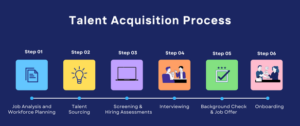There was a trend in some industries for companies to focus on Global Capability Centers (GCCs) for fresher hiring.
Table of Contents
ToggleGCCs, also known as global in-house centers or captive centers, are offshore subsidiaries or service centers set up by multinational companies to handle various functions such as IT services, research and development, and business process outsourcing.
The decision to hire fresher talent through GCCs often depends on several factors, including cost savings, access to a skilled workforce, and the desire for better control over operations. Companies may find that establishing or expanding GCCs allows them to tap into local talent pools and take advantage of cost efficiencies, while maintaining a level of control and integration with their global operations.
However, it’s essential to note that hiring trends can vary across industries, regions, and individual companies. Additionally, the landscape of the job market is dynamic, and new trends may have emerged since my last update. To get the most accurate and up-to-date information, it’s recommended to check recent industry reports, news sources, or reach out to professionals in the specific industry or region you are interested in.
Do GCC companies now have an edge over the IT giants in fresher hiring?

As of my last knowledge update in January 2022, the hiring landscape is dynamic and can be influenced by various factors such as economic conditions, industry trends, and specific company strategies. The competitiveness of Global Capability Centers (GCCs) versus IT giants in fresher hiring can vary based on multiple considerations.
GCCs are often established by multinational companies to set up offshore subsidiaries or service centers in specific regions, providing access to local talent pools and potential cost efficiencies. They may have certain advantages, such as a focused and controlled environment, alignment with the parent company’s goals, and a strategic location for talent acquisition.
However, IT giants, which are large, global technology companies, also have significant resources, brand recognition, and the ability to attract and retain top talent. These companies often have established hiring processes, training programs, and a wide range of projects that can appeal to fresh graduates.
Ultimately, the edge in fresher hiring depends on the specific circumstances, goals, and strategies of each company. Factors such as company culture, growth opportunities, compensation, and work-life balance can play a crucial role in attracting and retaining fresh talent.
Strategy opted by Dell in its GCC?
As of my last knowledge update in January 2022, Dell Technologies has been known to leverage Global Capability Centers (GCCs) as part of its global strategy. Dell, like many other multinational companies, uses GCCs to establish offshore subsidiaries or centers to handle various functions, including IT services, research and development, and business process outsourcing. These centers are often strategically located to tap into specific talent pools and benefit from cost efficiencies.
Dell’s strategy with its GCCs typically involves:
- Global Expansion and Cost Optimization: Dell, like many tech companies, looks to expand its global presence by establishing GCCs in regions with a skilled workforce. This allows the company to optimize costs by leveraging local talent and potentially benefitting from lower operational expenses.
- Operational Efficiency: GCCs can contribute to operational efficiency by streamlining specific functions, such as IT support, software development, or customer service. This allows Dell to maintain control over critical operations while potentially reducing costs.
- Innovation and Research: Companies often use GCCs to drive innovation and research and development initiatives. These centers can be hubs for technological advancements, helping Dell stay competitive in the rapidly evolving tech industry.
- Talent Development: Dell’s GCCs may play a role in talent development by providing training programs and opportunities for professional growth. This can be crucial for attracting and retaining skilled employees.
It’s important to note that specific details about Dell’s strategy with its GCCs, including the number of employees, locations, and areas of focus, can evolve over time. To obtain the most accurate and up-to-date information on Dell’s current strategy with its GCCs, it is recommended to check recent company announcements, official statements, or contact Dell directly for insights into its global operations.
Succession Planning:

Succession planning is a strategic process that involves identifying and developing individuals within an organization to ensure that key roles can be filled seamlessly when incumbents retire, resign, or otherwise leave their positions. It is a proactive approach to managing talent and leadership transitions, minimizing disruptions and ensuring continuity. Here are key components and best practices associated with succession planning:
- Identifying Key Roles: Begin by identifying critical roles within the organization. These are positions that, if left vacant, could have a significant impact on the company’s operations and goals.
- Talent Assessment: Evaluate the current workforce to identify employees with the potential to fill key roles in the future. Consider factors such as skills, experience, leadership qualities, and cultural fit.
- Leadership Development: Provide targeted development opportunities for high-potential employees. This may include training programs, mentorship initiatives, job rotations, and exposure to different aspects of the business.
- Communication and Transparency: Communicate the importance of succession planning to employees and involve them in the process when appropriate. Transparency about career development paths and potential leadership opportunities can boost morale and engagement.
- Performance Management: Tie succession planning to performance management. Regularly assess employee performance, and use this information to guide decisions about promotions, skill development, and career advancement.
- Diversity and Inclusion: Ensure that succession planning efforts consider diversity and inclusion. Encourage a diverse pool of candidates and provide equal opportunities for all employees to develop their skills and advance in their careers.
- Monitoring and Adjusting: Succession planning is an ongoing process that requires regular monitoring and adjustments. As business priorities and personnel change, revisit and update the succession plan to ensure its continued relevance.
- Knowledge Transfer: Develop strategies for knowledge transfer from experienced employees to those who are being groomed for leadership roles. This can involve mentoring, training sessions, and documentation of critical processes.
- Scenario Planning: Anticipate different scenarios and potential challenges in leadership transitions. Develop contingency plans to address unexpected departures or changes in leadership.
- Executive Involvement: Ensure that top leadership is actively involved in succession planning. Executives should champion the process, provide guidance, and support the development of future leaders.
- External Talent Consideration: While internal talent development is crucial, consider external candidates when necessary. This may involve actively scouting for external talent or having contingency plans for recruiting from the external market.
Effective succession planning is an integral part of talent management and organizational resilience. It helps companies build a pipeline of capable leaders, fosters a culture of continuous learning and development, and ensures that the organization is prepared for future challenges and opportunities.
Diversity and Inclusion

Diversity and inclusion (D&I) are essential components of a thriving and equitable workplace. These terms refer to the acknowledgment and appreciation of differences among individuals in an organization, including but not limited to race, ethnicity, gender, age, sexual orientation, physical abilities, socio-economic background, and more. Here are key aspects of diversity and inclusion in the workplace:
- Diversity:
- Demographic Diversity: Encompasses differences in characteristics such as race, ethnicity, gender, age, sexual orientation, religion, and physical abilities.
- Cognitive Diversity: Involves differences in perspectives, problem-solving approaches, and thinking styles.
- Experiential Diversity: Considers variations in life experiences, backgrounds, and skills.
- Inclusion:
- Inclusive Culture: Fosters an environment where every individual feels valued, respected, and heard, irrespective of their background or characteristics.
- Equity: Ensures fairness and impartiality in the treatment of all employees, addressing any existing disparities.
- Belonging: Creates a sense of belonging, where employees feel they are an integral part of the organization.
- Benefits of Diversity and Inclusion:
- Innovation: Diverse teams bring a range of perspectives, fostering creativity and innovation.
- Employee Engagement: Inclusive workplaces contribute to higher levels of employee engagement, satisfaction, and retention.
- Market Competitiveness: A diverse workforce is often more representative of a diverse customer base, enhancing the organization’s ability to understand and meet customer needs.
- Better Decision-Making: Inclusive decision-making processes, drawing on diverse viewpoints, can lead to better and more well-rounded decisions.
- Key Strategies for Promoting Diversity and Inclusion:
- Leadership Commitment: Leadership plays a crucial role in setting the tone for D&I initiatives. A commitment from the top is vital for success.
- Education and Training: Provide education and training programs to raise awareness, address unconscious bias, and promote cultural competence.
- Diverse Hiring Practices: Implement inclusive recruitment strategies to attract candidates from a variety of backgrounds.
- Employee Resource Groups (ERGs): Establish ERGs that provide a platform for employees to connect, share experiences, and contribute to a more inclusive workplace.
- Regular Assessments and Metrics: Monitor progress through regular assessments and establish metrics to track diversity and inclusion initiatives.
- Flexible Policies: Implement policies that support work-life balance, flexibility, and accommodation for diverse needs.
- Challenges:
- Unconscious Bias: Individuals may unknowingly hold biases that influence decision-making. Training can help address unconscious bias.
- Resistance to Change: Resistance from some employees or leaders who may feel threatened by changes to the status quo.
- Lack of Representation: Some groups may be underrepresented in certain industries or positions, requiring intentional efforts to address this imbalance.
Diversity and inclusion should be integral to an organization’s culture and values. When successfully implemented, they contribute to a more dynamic, innovative, and harmonious workplace that benefits both employees and the organization as a whole.
Campus hiring is a long-term investment:

Absolutely, campus hiring is indeed a long-term investment for organizations. This recruitment strategy involves hiring talented individuals directly from educational institutions, such as universities and colleges. Here are key reasons why campus hiring is considered a long-term investment:
- Fresh Talent Pipeline:
- Campus hiring allows organizations to tap into a pool of fresh and young talent with a diverse range of skills and perspectives.
- By building relationships with educational institutions, companies can create a continuous pipeline of entry-level talent for future needs.
- Skill Development and Moldability:
- Fresh graduates often bring a willingness to learn and adapt, making them moldable to the company’s culture and specific requirements.
- Organizations can invest in the skill development of new hires, shaping them into professionals who align with the company’s values and objectives.
- Cost-Effective Talent Acquisition:
- Campus hiring can be a cost-effective method of talent acquisition compared to hiring experienced professionals, especially when considering salary expectations.
- Investing in entry-level talent allows organizations to groom employees and reduce the need for expensive lateral hires.
- Cultural Fit:
- Campus hires have the potential to assimilate well into the company culture, as they are often more receptive to organizational values and norms.
- Building a strong cultural fit early on contributes to higher employee engagement and retention.
- Leadership Development:
- Organizations can identify and nurture high-potential individuals from early in their careers, grooming them for future leadership roles.
- Leadership development programs targeted at campus hires contribute to building a robust leadership pipeline.
- Innovation and Fresh Perspectives:
- Young talent often brings fresh ideas and perspectives, contributing to innovation within the organization.
- Campus hires can infuse new energy and creativity into teams, fostering a dynamic work environment.
- Building Employer Brand:
- Active engagement in campus hiring initiatives enhances an organization’s employer brand, making it more attractive to top-tier educational institutions.
- A positive employer brand contributes to sustained interest from high-caliber candidates.
- Long-Term Employee Retention:
- Organizations that invest in the professional growth and development of their campus hires are likely to experience higher retention rates.
- Providing clear career paths and advancement opportunities enhances loyalty and commitment.
- Adaptability to Organizational Needs:
- Campus hires can be molded to adapt to the specific needs and requirements of the organization, aligning with its strategic goals.
While campus hiring requires patience and ongoing investment in training and development, the long-term benefits in terms of a skilled workforce, leadership continuity, and a positive employer brand make it a strategic and valuable investment for many organizations.




